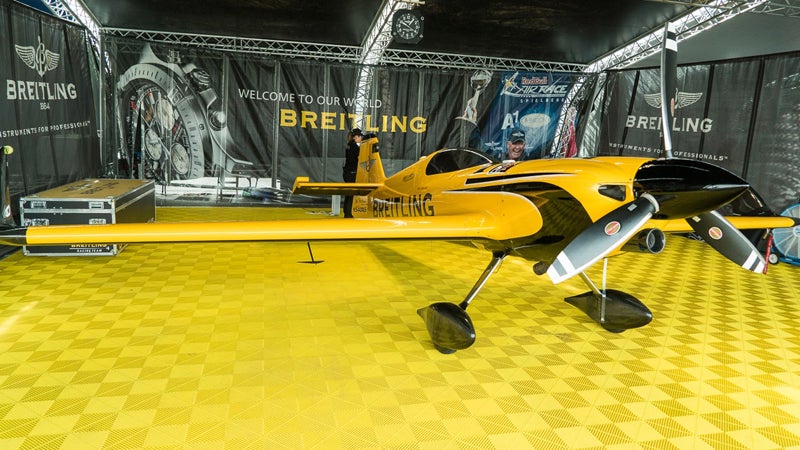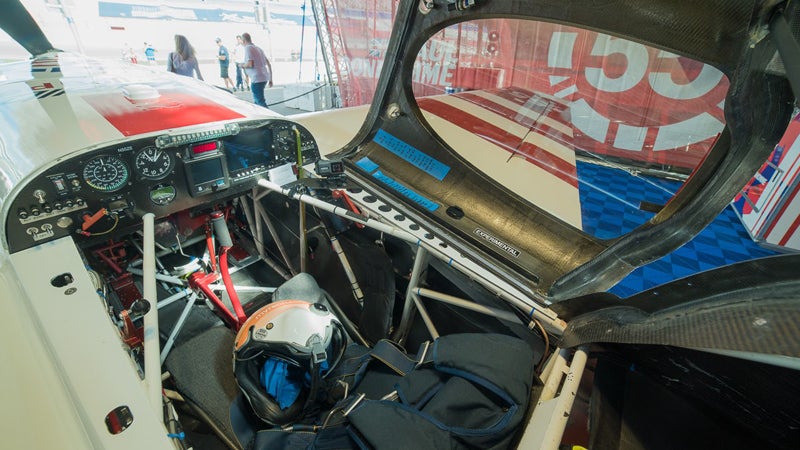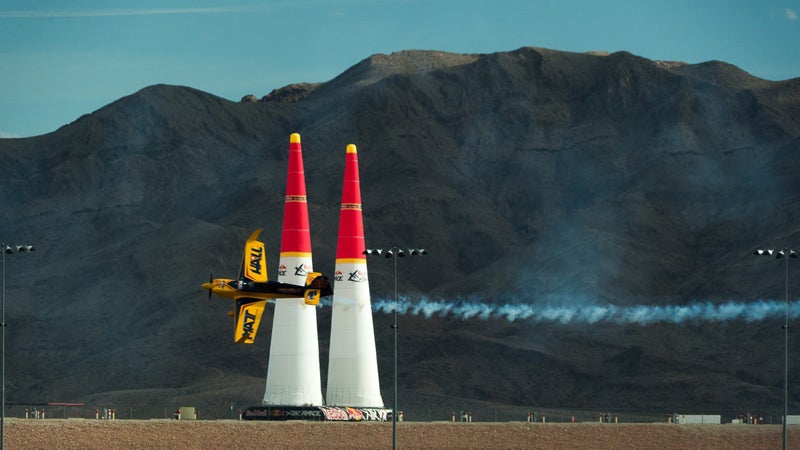The just finished up its 2015 season in Las Vegas a couple weeks ago. Dreams were crushed, world champions were crowned, and a bunch of amazing planes did things that seemed to violate the laws of physics. I got to ride on one, and I’m here to tell you that it’s pretty much the most fun you can have with your pants on.��
For those unfamiliar, the Air Race is an eight-race series that takes place all over the world. Small, incredibly agile, single-engine prop-planes go screaming through an obstacle course made of giant inflatable pylons, and whoever gets through the course fastest wins. All the planes have Lycoming Thunderbolt AEIO-540-EXP engines and Hartzell three-bladed 7690 propellers, but otherwise teams are free to tweak the plane's body to get them as fast as possible. The machines can reach speeds of about 260 miles per hour and can roll at a rate of 420 degrees per second. They aren’t as fast as a jet fighter, but they’re much more nimble.��

I showed up in Vegas for the final race of the series and was asked if I wanted to do a ridealong to experience what it feels like to do the course. That was one of the fastest yeses I’ve ever uttered. The plane they put me in had two seats versus one, but otherwise it was practically identical to a race plane. They strapped a parachute to me (just in case) and planted me in the front seat, while my pilot, Antanas Marciukaitis, sat down in back. Cockpit closed, radios checked, and we were headed to the runway.

Antanas told me, essentially, don’t be a hero. “If you start feeling sick, it only gets worse, so let me know right away,” he advised. I promised I would. I was told it would be hard to hear each other over the roar of the engine, so if I was okay, give him a thumbs up. If I wanted him to push it harder, give him two thumbs up. Got it. Moments later, we were careening down the runway and popping up into the air.��
The first thing we did was take a pass through an air gate made up of two inflatable pylons. The pylons are made of a lightweight tent-like material and are high pressure, so they tear away easily if an airplane wing nicks them. That didn’t stop me from contemplating the ramifications of a gust of wind blowing one into our propeller. This fear only grew as we got closer to the obstacle and I could see clearly just how little space we’d have on either side of the wings. Luckily, we made two clean passes and were off to the designated acrobatics area.

The cockpit had been set up so that either of us could pilot—which meant I needed to keep my hands well away from the stick and my feet off the pedals that control the flaps. I did my best to remember that as we went into a demo of what it felt like to run the actual race course.
It wasn’t easy.
The course begins with a quick slalom—called a chicane—as the plane quickly weaves between three pylons. Spectators see the plane’s wings go perfectly, smoothly vertical with each turn. On the inside of the plane, it’s pure violence. My helmet was instantly slammed into the right side of the cockpit glass, then the left, and then the right again. My head felt like a ping-pong ball. And then, woof, straight into a six-G vertical turn.
I’d been warned about these high G turns. I flexed my legs, butt, and abs in an attempt to keep all the blood from draining out of my head, which is what causes a blackout. At the top of this half-loop, we did a half roll and flipped back over. I was still feeling fine, so our nose dropped and we headed back down to do the course again in reverse. I felt like a ragdoll, but I was so utterly helpless all I could do was laugh. (I should note that in the actual race the planes pull closer to 10 Gs on that turn, but I guess they were unwilling to push me that hard.)
On the inside of the plane, it’s pure violence. My helmet was instantly slammed into the right side of the cockpit glass, then the left, and then the right again. And then, woof, straight into a six-G vertical turn.
Antanas then asked if I’d like to do some more advanced acrobatics, like loops and rolls. I told him to go nuts. What ensued was a series of quarter-turns that knocked my helmet against the cockpit glass every time. Then we started doing 360-degree rolls. That climaxed in a 1,440-degree roll (aka a quadruple). At that speed, you don’t feel the effects of being upside down. In fact, I found myself disassociating from reality, as if my vision of the world spinning round and round was just an image on the screen in front of me. I suppose it’s not something you can wrap your head around when experiencing it for the first time.
The big finale for me was experiencing negative Gs. Antanas had told me we wouldn’t be doing any because that’s what made most people sick, but by the end of the flight I was still feeling good, so I asked for it and he obliged. The best way I can describe negative Gs would be like this. Imagine a string coming out of the top of your head and someone swinging you around in a loop so that all the blood rushes to your dangling feet. That’s what positive Gs feel like. With negative Gs, the string is tied to your feet so the centrifugal force is pulling all the blood to your head. When you pass out from negative Gs, they call it redding, not blacking, out, because so much blood fills your head that red is the last thing you see. Red-outs like this can cause retinal damage and even hemorrhagic strokes. Not that I knew that when I asked for it.��
Once we were upside down, Antanas did a big, arcing half-loop, with our heads on the outside of the loop. Instantly I could feel my face fill with blood. None of the muscle-flexing techniques worked worth a damn. I could feel the veins in my neck expand and my vision took on a noticeable rouge. He completed the turn at negative four Gs, and I can tell you that four-G negative was at least twice as hard to handle as six-G positive. I was seeing stars for at least 60 seconds. Pilots don’t typically go negative during the Air Race, but I was glad I asked for it as it was a feeling unlike any I’ve ever experienced.
We landed safe and sound, I shook Antanas’ hand, and thanked him sincerely. My main takeaway: it's insane how agile these little planes are. They turn on a dime and, in the hands of a pilot who knows what he or she is doing, they can carve up the sky like an airborne Ginzu. If you can overcome your fear of death and you’re able to relax and enjoy the ride, you will find that hours later your jaw is still sore from grinning.
Brent Rose is a freelance writer and regular �����ԹϺ��� contributor. He is currently traveling the U.S. living in a high-tech van, looking for stories to tell. Follow his adventures on , , , and .��


